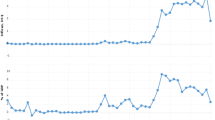Abstract
Foreign direct investment is generally expected to play a significant role as a multiplier of modern production and management know-how in Central Eastern European transition economies. The following paper examines the various mechanisms by which such technological spillover effects could in theory take place and compares them with the results of an empirical study of their practical significance for Hungarian industry.
Similar content being viewed by others
References
According to the geo-political definition suggested by Sundhausen, the region of Central Eastern Europe comprises Poland, Slovakia, Slovenia, the Czech Republic, Hungary and the three Baltic states of Estonia, Latvia and Lithuania (cf. H. Sundhausen: Osteuropa, Südosteuropa, Balkan: Überlegungen zur Konstruktion historischer Raumbegriffe, in: H. Sundhausen (ed.): Was ist Osteuropa? Interdisziplinäre Arbeitspapiere des Osteuropa-Instituts, No. 1, Berlin 1998, Osteuropa-Institut der Frien Universität Berlin, p. 5.
H. Klodt: Technologietransfer und internationale Wettbewerbsfähigkeit, in: Außenwirtschaft, Vol. 45, No. 1, 1990, pp. 57–79.
G. Hunya: International Competitiveness Impacts of FDI in CEECs. WIIW Research Report No. 268, Vienna 2000, Vienna Institute for International Economic Studies, p. 4.
G. Hunya: Integration of CEEC Manufacturing into European Corporate Structures via Direct Investment. WIIW Research Report No. 245, Vienna 1998, Vienna Institute for International Economic Studies; C. H. McMillan: Foreign Direct Investment in Eastern Europe: Harnessing FDI to the Transition from Plan to Market, in: S. Chan (ed.): Foreign Direct Investment in a Changing Global Political Economy, New York 1996, St. Martin's Press, p. 139.
P. Krugmann, M. Obstfeld: International Economics. Theory and Policy, Addison-Wesley 2000, pp. 169f.
IMF: Balance of Payments Manual, Fifth Edition, Washington 1993, International Monetary Fund, pp. 86f.
OECD: OECD Science, Technology and Industry Scoreboard 1999. Benchmarking Knowledge-based economics, Paris 1999, p. 72.
J. H. Dunning: Multinational Enterprises and the Global Economy, Addison-Wesley 1993, p. 3f.
R. E. Caves: Multinational Enterprise and Economic Analysis, Cambridge 1996, Cambridge University Press; J. H. Dunning, op. cit. Multinational Enterprises and the Global Economy, Addison-Wesley 1993, pp. 68f.
J. H. Dunning, op. cit. Multinational Enterprises and the Global Economy, Addison-Wesley 1993, pp. 75f.
Cf. e.g. M. Barz: Foreign direct investment and technology transfer: the case of Russia, Brighton 1998, Dissertation at Sussex University Brighton; J. Autschbach: Internationale Standortwahl: Direktinvestitionen der deutschen Automobilindustrie in Osteuropa, Wiesbaden 1997; B. Klagge: Internationalisierung des Bankwesens in Osteuropa: die ausländische Direktinvestitionstätigkeit im ungarischen und tschechischen Bankensektor im Spannungsfeld zwischen nationalen Bedigungen und der internationalen Niederlassungspolitik multinationaler Banken, Münster 1997.
M. Blomström, A. Kokko: Multinational Corporations and Spillovers, in: CEPR Discussion Paper, No. 1365, London 1996, Center for Economic Policy Research, pp. 48f.
G. Grossmann, E. Helpman: Innovation and Growth in the Global Economy, Cambridge 1997, pp. 15f.
B. Burger: Ausländische Direktinvestitionen, technologische Spillover-Effekte und industrielle Entwicklung, dargestellt am Beispiel Mexiko, Baden-Baden 1998, Nomos-Verlag, pp. 56f.
P. Mohnen: R&D Externalities and Productivity Growth, in STI Review: Science, Technology, Industry, No. 18, pp. 41.
(cf. J. H. Dunning, op. cit. Multinational Enterprises and the Global Economy, Addison-Wesley 1993, pp. 470 f.; E. Mansfield, A. Romeo: Technology Transfer to Overseas Subsidiaries by U.S.-Based Firms, in: The Quarterly Journal of Economics, Vol. 95, 1980, pp. 737–750).
J. H. Dunning, op. cit. Multinational Enterprises and the Global Economy, Addison-Wesley 1993, pp. 372f.
Ibid. J. H. Dunning, Multinational Enterprises and the Global Economy, Addison-Wesley 1993, pp. 446f.
M. Blomström: Most Country Benefits of Foreign Investment, in: D. G. McFetridge (ed.): Foreign Investment, Technology and Economic Growth, Toronto 1991, Toronto University Press, pp. 93–110.
S. Lamnek: Qualitative Sozialforschung, Volume 2: Methoden und Technik, Weinheim 1995, Psychologie Verlags Union, pp. 36ff.
S. Lamnek: Qualitative Sozialforschung, Volume 2: Methoden und Technik, Weinheim 1995, Psychologie Verlags Union, pp. 36ff.
S. Lamnek, op.cit., pp. 107f.
M. Meuser, U. Nagel: Expertinneninterviews—vielfach erprobt, wenig bedacht. Ein Beitrag zur qualitativen Methodendiskussion, in: D. Garz, K. Kraimer (eds.): Qualitativempirische Sozialforschung, Opladen 1991, Westdeutscher Verlag, pp. 441–468.
W. M. Cohen, D. A. Levinthal: ab]sorptive Capacity: A New Perspective on Learning and Innovation, in: Administrative Science Quarterly, Vol. 35, pp. 128–152.
EBRD: Transition Report 2000. Employment Skills and Transition. London 2000, European Bank for Reconstruction and Development.
OMFB: National Innovation System in Hungary, Budapest 1999, National Committee for Technological Development; A. Inzelt: The Transformation Role of FDI in R&D: Analysis Based on Material of a Datab]ank, in: D. A. Dyker, S. Radosevic (eds.): Innovation and Structural Change in Post-Socialist Countries: A Quantitative Approach, Dordrecht, Boston, London 1998, Kluwer Academic Publishers, pp. 185–201.
G. Csáki: Foreign Direct Investment in Hungary, in: Economic Trends and Research Summaries, No. 1, Budapest 1998, GKI-Economic Research Co., pp. 13–31; P. Farkas: The Effects of Foreign Direct Investment on R&D and Innovation in Hungary, Institute of World Economics, Working Paper, No. 108, Budapest 2000, Hungarian Academy of Sciences.
Hungarian Patent Office: Summary of Industrial Property Protection in Hungary, Budapest 1999; S. Smid: Intellectual Property Law Uniformity in the CEECs and the EU: Conformity Issues and an Overview, in: E. Altvater (ed.): Intellectual Property Rights in Central and Eastern Europe. The Creation of Favourab]le Legal and Market Preconditions, Berlin 1998, IOS Press, pp. 72–81.
DUIHK: Direktinvestitionen in Ungarn. Eine Umfrage zu Motiven, Erfahrungen und Zukunftsperspektiven deutscher Investoren in Ungarn, Budapest 1995, Deutsch-Ungarische Industrie- und Handelskammer.
Hungarian Ministry of Economic Affairs: Szechenyi-Plan. National Development Plan, Budapest 2000, pp. 39ff.
(cf. CSO: Hungary. Report on Major Processes in the Society and Economy, Budapest 2000, Central Statistical Office, pp. 68ff.; 170 companies have gone into the evaluation of the survey. 87% were SME (cf. MKIK: A külföldi tulajdonú vállalatok beszerzési politikájának vizsgálata a Közép-Magyarorszagon letelepedett cégek példajan. (Purchasing policy of Foreign Investment Companies—a survey of foreign firms in Central Hungary), in: MKIK-GVI Newsletter, Budapest November 2000, Hungary Chamber of Commerce and Industry (MKIK)).
MKKI, op. cit..
G. Hunya, op. cit. p. 13.
Author information
Authors and Affiliations
Rights and permissions
About this article
Cite this article
Günther, J. FDI as a multiplier of modern technology in Hungarian industry. Intereconomics 37, 263–269 (2002). https://doi.org/10.1007/BF02928885
Issue Date:
DOI: https://doi.org/10.1007/BF02928885




